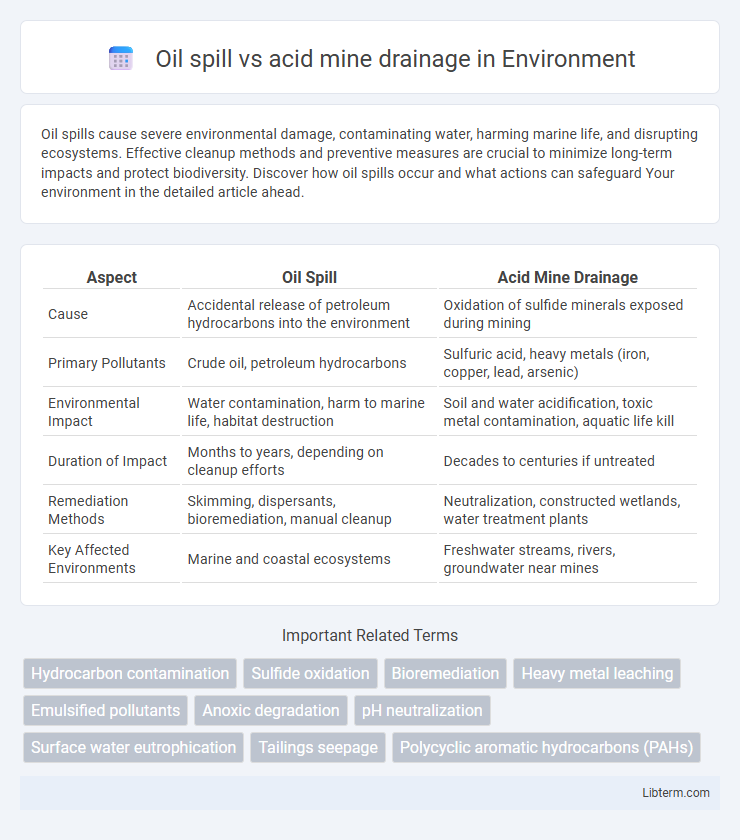Oil spills cause severe environmental damage, contaminating water, harming marine life, and disrupting ecosystems. Effective cleanup methods and preventive measures are crucial to minimize long-term impacts and protect biodiversity. Discover how oil spills occur and what actions can safeguard Your environment in the detailed article ahead.
Table of Comparison
| Aspect | Oil Spill | Acid Mine Drainage |
|---|---|---|
| Cause | Accidental release of petroleum hydrocarbons into the environment | Oxidation of sulfide minerals exposed during mining |
| Primary Pollutants | Crude oil, petroleum hydrocarbons | Sulfuric acid, heavy metals (iron, copper, lead, arsenic) |
| Environmental Impact | Water contamination, harm to marine life, habitat destruction | Soil and water acidification, toxic metal contamination, aquatic life kill |
| Duration of Impact | Months to years, depending on cleanup efforts | Decades to centuries if untreated |
| Remediation Methods | Skimming, dispersants, bioremediation, manual cleanup | Neutralization, constructed wetlands, water treatment plants |
| Key Affected Environments | Marine and coastal ecosystems | Freshwater streams, rivers, groundwater near mines |
Introduction to Oil Spill and Acid Mine Drainage
Oil spills involve the release of petroleum hydrocarbons into marine or terrestrial environments, causing severe ecological damage by contaminating water, soil, and harming aquatic life. Acid mine drainage results from the oxidation of sulfide minerals exposed during mining, producing sulfuric acid that leaches heavy metals into surrounding water bodies, leading to long-term environmental toxicity. Both phenomena represent critical sources of pollution with distinct chemical processes and devastating impacts on ecosystems and water quality.
Causes and Sources of Oil Spills
Oil spills primarily result from tanker accidents, pipeline ruptures, offshore drilling blowouts, and operational discharges during oil extraction and transportation. Natural seepage from ocean floor reservoirs also contributes to the release of crude oil into marine environments. Understanding these sources is crucial for implementing effective prevention and response strategies in marine pollution management.
Causes and Sources of Acid Mine Drainage
Acid mine drainage (AMD) primarily originates from the exposure of sulfide minerals, such as pyrite, to oxygen and water during mining operations, leading to the generation of sulfuric acid. Unlike oil spills caused by accidental releases of petroleum products from pipelines, tankers, or drilling activities, AMD results from the chemical oxidation of mine tailings and waste rock. The presence of metal sulfides in abandoned coal mines, metal ore mines, and spoil piles is the dominant source driving the formation of acid mine drainage.
Chemical Composition Differences
Oil spills primarily consist of complex hydrocarbons, including alkanes, aromatics, resins, and asphaltenes, characterized by their hydrophobic and non-polar chemical nature. Acid mine drainage contains high concentrations of sulfuric acid, dissolved heavy metals like iron, copper, and zinc, resulting from the oxidation of sulfide minerals such as pyrite. The stark contrast lies in oil spills being organic carbon-based pollutants, whereas acid mine drainage is an acidic, metal-laden aqueous solution.
Environmental Impacts Compared
Oil spills release toxic hydrocarbons that contaminate marine and coastal ecosystems, severely affecting fish, seabirds, and marine mammals by disrupting reproduction and causing mortality. Acid mine drainage generates highly acidic water enriched with heavy metals, leading to long-term soil and freshwater degradation, harming aquatic life and reducing biodiversity. Both pollutants result in persistent environmental damage, but acid mine drainage typically causes prolonged contamination of freshwater systems, while oil spills cause immediate but often recoverable damage to marine habitats.
Effects on Aquatic Ecosystems
Oil spills cause toxic contamination in aquatic ecosystems by coating water surfaces and marine organisms, leading to oxygen depletion and disrupting food chains. Acid mine drainage introduces highly acidic, metal-laden waters that lower pH levels, causing heavy metal toxicity and habitat degradation for aquatic species. Both pollutants result in long-term biodiversity loss, impaired reproductive cycles, and altered ecosystem functions in affected water bodies.
Human Health Implications
Oil spills expose humans to toxic hydrocarbons causing respiratory issues, skin irritation, and long-term carcinogenic risks, especially in communities reliant on fishing and coastal resources. Acid mine drainage releases heavy metals like arsenic and lead into water supplies, leading to neurological disorders, kidney damage, and increased cancer risk through contaminated drinking water. Both environmental disasters demand urgent public health interventions to prevent chronic exposure and mitigate severe health outcomes.
Remediation and Cleanup Techniques
Oil spill remediation employs techniques such as skimming, bioremediation using oil-degrading microbes, and chemical dispersants to break down hydrocarbons and reduce environmental impact. Acid mine drainage cleanup focuses on neutralizing acidity through lime addition, constructing wetlands for passive treatment, and employing active treatment systems that precipitate heavy metals. Both methods require continuous monitoring to prevent long-term ecosystem damage and ensure effectiveness of remediation efforts.
Prevention and Regulatory Strategies
Prevention of oil spills centers on rigorous pipeline inspections, double-hulled tanker designs, and rapid response protocols to contain leaks. Acid mine drainage is mitigated through proper mine waste management, including neutralizing agents and engineered covers to prevent sulfide oxidation. Regulatory strategies enforce strict environmental standards, mandatory monitoring, and substantial penalties under agencies such as the EPA, ensuring compliance with both oil spill prevention and acid mine drainage control measures.
Case Studies: Major Incidents and Lessons Learned
The Exxon Valdez oil spill in 1989 released approximately 11 million gallons of crude oil into Prince William Sound, Alaska, highlighting weaknesses in tanker design and response coordination, which led to stricter regulations like the Oil Pollution Act of 1990. The Acid Mine Drainage disaster at the Wheal Jane mine in Cornwall, UK, during the 1990s resulted in the release of highly acidic, heavy metal-laden water, emphasizing the need for long-term mine water treatment solutions and improved regulatory oversight. Both incidents demonstrate the critical importance of robust environmental monitoring, emergency preparedness, and remediation strategies to mitigate the severe ecological and economic impacts of such contaminations.
Oil spill Infographic

 libterm.com
libterm.com